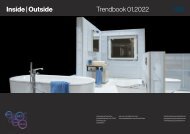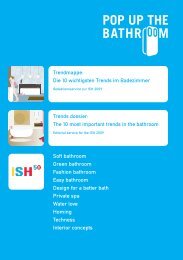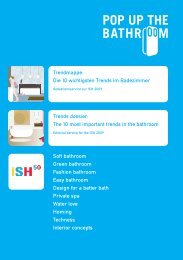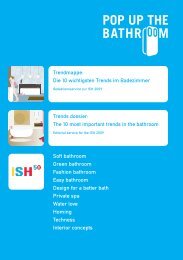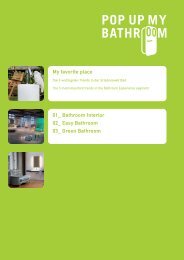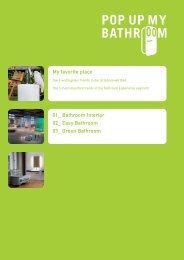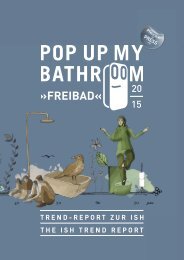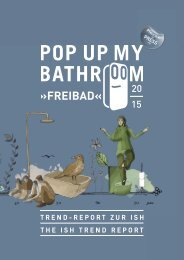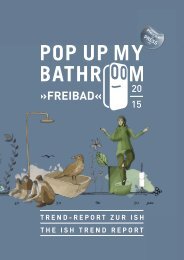My favorite place - Trendbook Pop up my Bathroom | Issue 01/2011 ISH 2011
Today’s bathrooms are no longer chilly, wipe-clean functional cells. Bathrooms are turning into living space. As simple as this meanwhile ubiquitously manifest megatrend might sound, its impact on the sanitary industry and the conceptual possibilities for bathroom design are nothing short of revolutionary. As a result, expectations of the aesthetics and functionality of contemporary bathroom design are growing. Accordingly, there will be more than “just” new products on show at the world’s leading fair for the sanitary industry, the ISH in Frankfurt. For it is not the bathtub that is being reinvented, but the entire bathroom.
Today’s bathrooms are no longer chilly, wipe-clean functional cells. Bathrooms are turning into living space. As simple as this meanwhile ubiquitously manifest megatrend might sound, its impact on the sanitary industry and the conceptual possibilities for bathroom design are nothing short of revolutionary. As a result, expectations of the aesthetics and functionality of contemporary bathroom design are growing. Accordingly, there will be more than “just” new products on show at the world’s leading fair for the sanitary industry, the ISH in Frankfurt. For it is not the bathtub that is being reinvented, but the entire bathroom.
Create successful ePaper yourself
Turn your PDF publications into a flip-book with our unique Google optimized e-Paper software.
Vollbad ist nun einmal ein ganz besonderer<br />
Luxus – nicht nur unter Umweltschutzaspekten.<br />
Beim Wasserbedarf moderner WC-Anlagen ist<br />
das Einsparpotenzial bereits bis an die Grenze<br />
entwickelt worden. Während das 3-Liter-Auto<br />
noch nicht wirklich überzeugt, kommen moderne<br />
Toiletten wie etwa das WC Omnia Green<br />
Gain von Villeroy & Boch durchaus mit 3,5 Litern<br />
Spülwasser aus, ohne dass Hygiene- oder Geruchsprobleme<br />
entstehen. Gleich ganz ohne<br />
Wasser kommt das 0-Liter Urinal McDry von<br />
Duravit aus und bietet damit gerade für den<br />
(halb-)öffentlichen Bereich einen innovativen<br />
Ansatz zum Wassersparen.<br />
Aber es geht im Green <strong>Bathroom</strong> nicht nur darum,<br />
Wasser zu sparen. Wasser bedeutet auch<br />
Lebenslust und Sinnlichkeit – vor allem in einer<br />
modernen Badkultur. Die Beliebtheit formschöner<br />
Armaturen, die das Wasser sinnlich<br />
inszenieren und natürlich wirken lassen, zeigt,<br />
wie wichtig den Menschen der Kontakt zum<br />
Lebenselement Wasser ist. Schwallarmaturen,<br />
von denen inzwischen auch sparsame Modelle<br />
erhältlich sind, und drucklos wasserspendende<br />
Armaturen, wie sie etwa Dornbracht in seinem<br />
Programm Performing Shower anbietet, lassen<br />
das technisch aufwendige Innenleben vergessen<br />
und rücken uns den großen Wert der Ressource<br />
Wasser ins Bewusstsein.<br />
Denn Trinkwasser ist nicht unendlich vorhanden<br />
– während die Weltbevölkerung laut UNO<br />
bis zum Jahr 2050 auf 9,3 Milliarden Menschen<br />
anwachsen wird, bleibt das globale Trinkwasservolumen<br />
gleichbleibend auf 12.000 km 3 beschränkt.<br />
Damit wird Wasser in der Zukunft zu<br />
einer knappen und womöglich umkämpften<br />
Ressource. Nicht umsonst haben die Vereinten<br />
Nationen im Sommer 2<strong>01</strong>0 den Anspruch auf<br />
reines Wasser in die Allgemeine Erklärung der<br />
Menschenrechte aufgenommen. Selbst wenn<br />
die Resolution bislang wohl eher symbolischen<br />
Wert hat, zeigt sie doch die Verantwortung der<br />
Industrienationen. So hat etwa Deutschland trotz<br />
der durch Bodenversiegelung verursachten Absenkung<br />
des Grundwasserspiegels zwar keinen<br />
akuten Wassermangel zu befürchten, doch bekennt<br />
sich die deutsche Sanitärwirtschaft durchaus<br />
zu einer „weltweiten Führungsrolle“ bei<br />
der Entwicklung und Produktion fortschrittlicher<br />
Wassertechnologie-Systeme, hatte Jens J. Wischmann,<br />
Geschäftsführer der Vereinigung Deutsche<br />
Sanitärwirtschaft (VDS), bereits aus Anlass des<br />
weltweiten „Tag des Wassers“ im März 2<strong>01</strong>0<br />
ausgeführt.<br />
Lehm, gebackenes Holz und zermahlender Stein<br />
Ein ganz anderer Aspekt bei der Planung eines<br />
nachhaltigen Bades ist die Materialfrage. Denn<br />
so schön ein weicher Moosteppich und Holzdielen<br />
auch sein mögen: Fliesen, Stein oder<br />
Beton sind praktischer und wasserunempfindlicher.<br />
Geeignete Badmöbel in wohnlichem Design<br />
sind inzwischen von etlichen Anbietern und in<br />
vielen Programmvarianten zu haben. Wer auf<br />
Massivholz im Bad nicht verzichten will, sollte<br />
Möbel aus zertifiziertem Holz wählen. Und als<br />
Ausbaualternative zu feuchtraumresistenten Tropenhölzern<br />
bieten sich einheimische Thermoholzqualitäten<br />
an – so genanntes „gebackenes“,<br />
also durch thermische Behandlung unempfindlich<br />
gemachtes Holz. Ein besonders natürliches<br />
Raumklima kann man im Übrigen heute auch<br />
mit Lehmwänden oder mit modernen Lehmputzen<br />
erzielen, die – zumindest außerhalb des<br />
direkten Spritzwasserbereichs – durchaus für<br />
Feuchträume geeignet sind, denn sie binden<br />
Feuchtigkeit und wirkend klimaausgleichend,<br />
wodurch auch der Schimmelbildung vorgebeugt<br />
werden kann. Und wer es genauso exklusiv wie<br />
natürlich mag, kommt heute am Tadelakt nicht<br />
vorbei, jenem aus dem Orient stammenden Kalkputz,<br />
der durch das Einpolieren von Olivenseife<br />
wasserdicht wird und eine unnachahmliche<br />
Patina erhält.<br />
47<br />
has already been pushed to the limit. Whereas<br />
the 3-litre car is not yet totally convincing,<br />
modern toilets like the Omnia Green Gain<br />
model by Villeroy & Boch can easily manage<br />
with 3,5 litres of water per flush without leading<br />
to hygiene problems or unpleasant odours. The<br />
0-litre McDry urinal by Duravit even dispenses<br />
with water entirely, thus providing an innovative<br />
approach to saving water in (semi) public<br />
facilities.<br />
But there’s more to a Green <strong>Bathroom</strong> than<br />
saving water. Water means vitality and<br />
sensuousness as well – especially in modern<br />
bathroom culture. The popularity of beautifully<br />
shaped fittings that stage the water in a sensuous<br />
and natural way indicates just how important<br />
contact with the life-giving element is to people.<br />
Cascade fittings, which are now available in<br />
economical versions as well, and fittings that<br />
dispense unpressurised water, such as those in<br />
Dornbracht’s PerformingShower range, make<br />
us forget the elaborate inner workings and<br />
remind us that water is an immensely valuable<br />
resource.<br />
For drinking water is not available in infinite<br />
quantities – whilst UNO predicts that the<br />
world’s population will grow to 9.3 billion people<br />
by 2050, the volume of drinking water on<br />
the face of the planet will remain unchanged<br />
at 12,000 km³. In the future, water is thus set to<br />
become a scarce and possibly even contested<br />
resource. It is no coincidence that, in summer<br />
2<strong>01</strong>0, the United Nations added the right to<br />
clean water to the Universal Declaration of<br />
Human Rights. Even if the importance of the<br />
resolution is still largely symbolic right now, it<br />
nevertheless points to the responsibility facing<br />
industrial nations. Although Germany, for<br />
instance, has no need to fear an acute water<br />
shortage – despite the drop in the groundwater<br />
level as a result of soil sealing – the German<br />
sanitary industry has nevertheless pledged to<br />
play a “leading international role” when it<br />
comes to the development and production of<br />
progressive water technology systems, explained<br />
Jens J. Wischmann, managing director of the<br />
German Sanitary Industry Association<br />
(Vereinigung Deutsche Sanitärwirtschaft, VDS),<br />
on the occasion of “World Water Day” in<br />
March 2<strong>01</strong>0.<br />
Loam, baked wood and crushed stone<br />
When it comes to planning a sustainable bathroom,<br />
the question of materials is a totally different<br />
but highly important aspect. For as nice<br />
as a soft mossy carpet and wooden floorboards<br />
might be, tiles, stone or concrete are far more<br />
practical and less water-sensitive. Nowadays<br />
suitable bathroom furniture with a snug design<br />
is available from a number of providers and in<br />
a wide range of variants. Those who don’t want<br />
to go without solid wood in the bathroom<br />
should choose furniture made of certified<br />
timber. And for finishing, thermally modified<br />
wood from domestic sources – timber that has<br />
been “baked” to make it less sensitive – is a<br />
good alternative to humidity-resistant tropical<br />
wood. Incidentally: loam walls or modern<br />
loam plaster make for a particularly natural indoor<br />
climate. As long as they are used outside<br />
the immediate splash zone, these materials are<br />
definitely suitable for humid rooms because<br />
they bind moisture and have a climateregulating<br />
effect, which can also help prevent<br />
mould. And for those who like things to be<br />
not just natural but exclusive too, tadelakt is<br />
a must. The lime plaster originates from the<br />
Orient and is waterproofed by polishing it with<br />
olive oil soap to create a distinctive patina.<br />
Green <strong>Bathroom</strong> devotees have it comparatively<br />
easy when it comes to choosing the material<br />
for their sanitaryware: it is hard to think<br />
of any other material that is as innocuous<br />
to produce, as safe for the occ<strong>up</strong>ants of the



